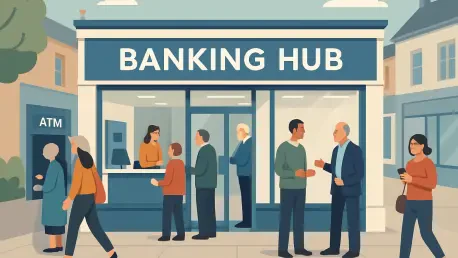In an era where digital transactions dominate financial interactions, the landscape of traditional banking in the UK is undergoing a seismic shift, prompting major institutions to rethink their physical presence while addressing the needs of diverse customer bases. Lloyds Banking Group, a prominent player encompassing Lloyds, Halifax, and Bank of Scotland, has made headlines with its decision to shutter numerous branches across the region. This move, driven by a surge in online banking, reflects a broader industry trend toward digital solutions. Yet, as branches close, the emergence of shared banking hubs offers a lifeline to communities reliant on in-person services. This evolving scenario raises critical questions about accessibility and the balance between technological progress and the preservation of essential financial touchpoints for all.
Navigating Branch Closures
Impact on Physical Banking Presence
The decision by Lloyds Banking Group to close 49 additional branches—comprising 26 Lloyds, 10 Halifax, and 13 Bank of Scotland locations—marks a significant reduction in its physical footprint, bringing the total network down to 705 branches. These closures, spread across various regions including Scotland, target specific locations such as Grangemouth and Glasgow Anniesland. The rationale behind this strategy lies in the dramatic shift in customer behavior, with over 21 million individuals now relying on mobile apps for their everyday banking needs. This digital pivot has rendered many traditional branches less viable from a cost perspective. To cushion the impact on employees, the bank has committed to providing alternative roles within the organization for all staff affected by these closures, ensuring that job losses are minimized during this transition.
Community and Customer Reactions
As news of the branch closures spreads, the impact on local communities becomes a focal point of concern, particularly in areas where physical banking remains a necessity for many residents. For some, especially older customers or those without reliable internet access, the loss of a nearby branch represents more than just an inconvenience—it’s a barrier to managing finances. The affected regions, often smaller towns or suburban areas, may struggle with reduced access to cash and face-to-face consultations. Lloyds has acknowledged these challenges and emphasized efforts to mitigate them through alternative service points. However, the emotional and practical toll on customers who value personal interaction with bank staff cannot be understated, highlighting a divide between digital adopters and those tied to traditional banking methods.
Rise of Shared Banking Hubs
A Collaborative Solution for Cash Access
In response to the wave of branch closures, the cash access network Link has spearheaded the creation of 244 recommended banking hubs across the UK, with 11 new locations recently unveiled, including one in Grangemouth. These hubs, managed by Cash Access UK, serve as shared spaces where customers from multiple banks can access essential services such as cash withdrawals, deposits, and bill payments through Post Office-operated counters. Additionally, private areas within these hubs facilitate more complex discussions with community bankers from various institutions on a rotating schedule. With 186 hubs currently operational and a government pledge to reach 350 during the current parliamentary term, this initiative addresses the void left by diminishing branch networks, ensuring that cash remains available on high streets for the millions who still depend on it.
Balancing Digital Trends with Traditional Needs
The introduction of banking hubs underscores a critical tension in the banking sector: the rapid rise of digital platforms versus the enduring need for physical access points. John Howells, CEO of Link, has stressed the importance of maintaining cash availability, recognizing that a significant portion of the population relies on physical currency for daily transactions. Meanwhile, Lloyds supports this hybrid model by complementing hubs with other access options like Post Office services and over 30,000 PayPoint locations for cash deposits. This dual strategy reflects an industry-wide acknowledgment that while digital banking offers unmatched convenience, it cannot fully replace the tangible support that in-person services provide to vulnerable or less tech-savvy customers, creating a bridge between two divergent banking realities.
Reflecting on Banking’s Future Path
Lessons from Adaptation Efforts
Looking back, the closures orchestrated by Lloyds Banking Group mirrored a wider pattern among retail banks, driven by the twin forces of cost efficiency and evolving consumer preferences toward online platforms. The reduction in physical branches was a pragmatic response to a world increasingly comfortable with digital interfaces. Yet, the simultaneous rollout of shared banking hubs stood out as a testament to the industry’s recognition that not all customers could or would transition seamlessly to virtual banking. This balance of trimming physical presence while bolstering alternative access points revealed a nuanced approach to modernization, one that sought to preserve essential services even as the digital tide surged.
Moving Forward with Inclusive Strategies
As the banking sector continues to evolve, the focus must shift toward refining these hybrid models to ensure no community is left behind. Stakeholders should prioritize expanding the reach of banking hubs, particularly in underserved rural and suburban areas where branch closures hit hardest. Collaboration between banks, government bodies, and organizations like Link will be crucial in meeting ambitious targets for hub deployment. Additionally, investing in education around digital tools can help bridge the gap for hesitant users while maintaining robust in-person options for those who need them. This multifaceted strategy promises a more inclusive financial landscape, harmonizing technological advancements with the enduring value of accessibility.









